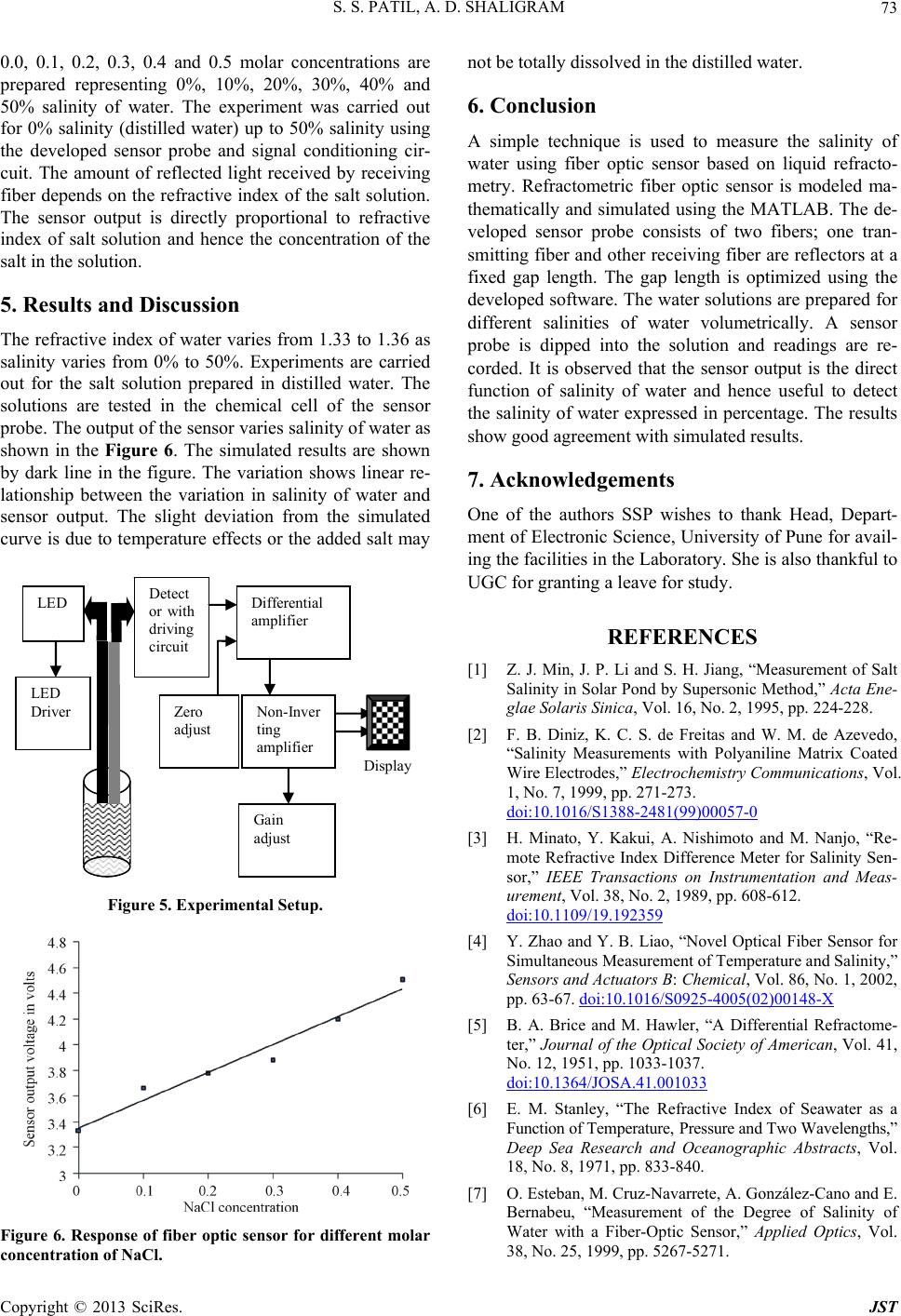
S. S. PATIL, A. D. SHALIGRAM 73
0.0, 0.1, 0.2, 0.3, 0.4 and 0.5 molar concentrations are
prepared representing 0%, 10%, 20%, 30%, 40% and
50% salinity of water. The experiment was carried out
for 0% salinity (distilled water) up to 50% salinity using
the developed sensor probe and signal conditioning cir-
cuit. The amount of reflected light received by receiving
fiber depends on the refractive index of the salt solution.
The sensor output is directly proportional to refractive
index of salt solution and hence the concentration of the
salt in the solution.
5. Results and Discussion
The refractive index of water varies from 1.33 to 1.36 as
salinity varies from 0% to 50%. Experiments are carried
out for the salt solution prepared in distilled water. The
solutions are tested in the chemical cell of the sensor
probe. The output of the sensor varies salinity of water as
shown in the Figure 6. The simulated results are shown
by dark line in the figure. The variation shows linear re-
lationship between the variation in salinity of water and
sensor output. The slight deviation from the simulated
curve is due to temperature effects or the added salt may
LED
Driver
Detect
or with
driving
circuit
Display
LED Differential
amplifier
Zero
adjust
Non-Inver
ting
amplifier
Gain
adjust
Figure 5. Experimental Setup.
Figure 6. Response of fiber optic sensor for different molar
concentration of NaCl.
not be totally dissolved in the distilled water.
6. Conclusion
A simple technique is used to measure the salinity of
water using fiber optic sensor based on liquid refracto-
metry. Refractometric fiber optic sensor is modeled ma-
thematically and simulated using the MATLAB. The de-
veloped sensor probe consists of two fibers; one tran-
smitting fiber and other receiving fiber are reflectors at a
fixed gap length. The gap length is optimized using the
developed software. The water solutions are prepared for
different salinities of water volumetrically. A sensor
probe is dipped into the solution and readings are re-
corded. It is observed that the sensor output is the direct
function of salinity of water and hence useful to detect
the salinity of water expressed in percentage. The results
show good agreement with simulated results.
7. Acknowledgements
One of the authors SSP wishes to thank Head, Depart-
ment of Electronic Science, University of Pune for avail-
ing the facilities in the Laboratory. She is also thankful to
UGC for granting a leave for study.
REFERENCES
[1] Z. J. Min, J. P. Li and S. H. Jiang, “Measurement of Salt
Salinity in Solar Pond by Supersonic Method,” Acta Ene-
glae Solaris Sinica, Vol. 16, No. 2, 1995, pp. 224-228.
[2] F. B. Diniz, K. C. S. de Freitas and W. M. de Azevedo,
“Salinity Measurements with Polyaniline Matrix Coated
Wire Electrodes,” Electrochemistry Communications, Vol.
1, No. 7, 1999, pp. 271-273.
doi:10.1016/S1388-2481(99)00057-0
[3] H. Minato, Y. Kakui, A. Nishimoto and M. Nanjo, “Re-
mote Refractive Index Difference Meter for Salinity Sen-
sor,” IEEE Transactions on Instrumentation and Meas-
urement, Vol. 38, No. 2, 1989, pp. 608-612.
doi:10.1109/19.192359
[4] Y. Zhao and Y. B. Liao, “Novel Optical Fiber Sensor for
Simultaneous Measurement of Temperature and Salinity,”
Sensors and Actuators B: Chemical, Vol. 86, No. 1, 2002,
pp. 63-67. doi:10.1016/S0925-4005(02)00148-X
[5] B. A. Brice and M. Hawler, “A Differential Refractome-
ter,” Journal of the Optical Society of American, Vol. 41,
No. 12, 1951, pp. 1033-1037.
doi:10.1364/JOSA.41.001033
[6] E. M. Stanley, “The Refractive Index of Seawater as a
Function of Temperature, Pressure and Two Wavelengths,”
Deep Sea Research and Oceanographic Abstracts, Vol.
18, No. 8, 1971, pp. 833-840.
[7] O. Esteban, M. Cruz-Navarrete, A. González-Cano and E.
Bernabeu, “Measurement of the Degree of Salinity of
Water with a Fiber-Optic Sensor,” Applied Optics, Vol.
38, No. 25, 1999, pp. 5267-5271.
Copyright © 2013 SciRes. JST